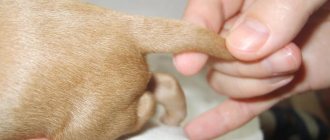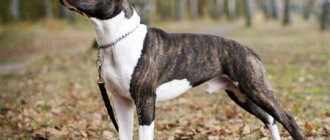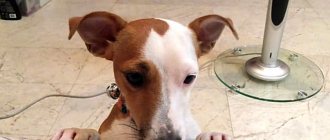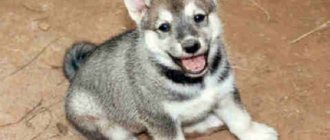- February 21, 2020
- Dogs and hunting with them
- Larisa Kozyrka
Why do you need to dock a spaniel's tail and when is the best time to do this procedure? The tradition of cropping dogs' tails and ears began to spread back in Ancient Rome. Dog fighting was a favorite pastime of that time, and the main goal of docking was the invulnerability of the fighting dog. There is simply nothing for the fighting dog’s opponent to grab him by during the fight. Nowadays, some breeds, and in particular spaniels, also need this procedure.
Often owners attach great importance to docking just because it is considered aesthetically pleasing and beautiful for some dog breeds. Docking spaniels is a standard for this breed, and if this dog is used during hunting, it is also a necessity.
When is ear circumcision performed?
When to crop ears depends on the breed of dog. Usually this is 2.5 or 3 months of age, but in some cases a dog’s ears can be cropped up to a year.
In small breeds of dogs, docking is carried out earlier; in large breeds, which have thick skin, the ears are formed later.
Read also: How to run a marathon on Instagram
The timing is affected by the shape of the head and its changes with age. In small puppies, it is impossible to determine how the proportions of the head and ears will change after a month or two. Improper trimming can ruin the dog's entire appearance.
Cosmetic surgeries: techniques, postoperative care, complications
The most popular cosmetic surgeries include ear surgery, tail docking, and dewclaw removal. They can be performed for medical reasons or for aesthetic reasons.
Tail docking
Tail docking is performed in one of two ways:
- Bandaging. It is carried out from the 2nd to 4th day of life. The tail is tightened with a thread, an elastic band, a special ring, and sometimes orthodontic thread is applied. This effectively cuts off the blood supply. On average, after 3 days the tail dies and falls off.
- Surgical. A one-time tail trimming at 3-7 days of age using a scalpel or other suitable surgical instrument, with or without sutures.
Complications
Complications after surgery in newborns are rare. This may be bleeding or inflammation in the wound area. Often caused by improper postoperative care or unsanitary conditions in places of detention. In older dogs, the risk of unwanted consequences increases, and prolonged scarring can greatly spoil the appearance. Improper use of the compression ring can cause necrosis and sepsis.
The length of the docked tail depends on the breed and is often specified in the Standard. For example, in a Jack Russell Terrier, the tip of the cut tail should be at ear level when standing.
Development
Puppies are born blind and deaf. Their taste and sense of smell are well developed. Around the 12th - 14th day, the puppies' eyes open and they begin to flinch at strong sounds. Around the 20th day, coordination of movements improves and teeth erupt, after which tail wagging appears.
Soon they gradually begin to explore the space around the nest, and by 18 days they begin to play with each other, growl and bark. If before this the dog’s nest was fenced with a barrier to prevent the puppies from crawling away, now it is better to remove the fence. After all, the puppy must acquire both an eye and coordination of movements outside the nest, he needs to develop, but this is impossible in the “box”. It has been noticed that puppies, not limited in their exploration of the surrounding world, become more independent by the time of distribution, more easily tolerate removal from their native environment, and subsequently have a more stable nervous system.
At what age should a dog's tail be docked?
- 3-10 days
. Veterinarians recommend docking the tail of puppies in the first 3-10 days from birth. During this period, ossification of the tail vertebrae has not yet occurred and pain sensitivity is lower than in older dogs. For such puppies, the operation is performed without anesthesia and without stitches. The breeder or owner is obliged to ensure that the mother of the puppies does not lick the wound, so it will take longer to heal. In this case, the operated animals are isolated and brought in only for feeding time. - from 10 days
. In dogs 10 days and older, the operation is performed under local or general anesthesia. The animal is placed on the operating table in the prone position. The hind and front legs are tied, allowing access to the surgical field. A fixing band is pulled across the body. The jaws are tied with a bandage or a muzzle is put on. - 3-4 weeks
. If the animal is more than 3-4 weeks old, then a tourniquet is applied to the base of the tail.
Short description
Most spaniels are small or medium-sized dogs, the most characteristic external features of which are long floppy ears and a good-natured look of expressive eyes .
Spaniels have coats of different lengths: short on the head and front of the legs, medium length on the body and long in the fringe area.
The body is square or close to square. However, some spaniels, such as Clumbers or Sussexes, have a stretched format, which makes them look rather squat.
The head is proportional to the body, with a flattened or slightly rounded skull and a square muzzle that almost does not taper towards the nose.
The neck is of medium length, with a beautiful curve and proud carriage, the back is straight and level, the chest is well developed, the stomach is slightly tucked.
The limbs are parallel, strong, moderately muscular.
The tail is carried in line with the back or slightly lower. Representatives of many breeds have traditionally docked tails, as this helps to avoid injury during hunting.
The coat of land spaniels is silky and soft.
A characteristic feature of water spaniels is their short hair, which forms small tight curls that protect the dog from water, dirt and adverse weather conditions..
Tail docking
The decision made to circumcise the appendage must be correctly translated into reality:
- Cupping is carried out in the first days of the pet’s life (up to 5 days);
- Further pruning is carried out up to 2.5 months. In this case, the appendix is anesthetized (local), sutures are applied;
- Adult dogs have their tail docked as needed. The procedure is performed under general anesthesia;
- The need is justified by a number of injuries - festering wounds, fractures, burns;
- Surgery is strictly contraindicated for sick puppies.
The need to trim the mobile appendage at an early age is argued for physiological reasons:
- Until 5 days of life, puppies do not see or hear;
- Pain sensations are dulled - pets do not squeak when pruning;
- The wound does not require sutures due to its small size;
- The stump heals quickly due to the peculiarities of the blood supply to this area;
- Moral injury does not occur due to a lack of understanding of what is happening.
Answer
Good afternoon. The question of whether a spaniel's tail needs to be docked is decided individually by the puppy's owner. This is not to say that this is a strict necessity. This procedure will be beneficial for the hunting dog. When getting a companion puppy, it is recommended to leave the tail long. Planning to take your pet to exhibitions and shows since 2006, there is also no need to trim the tail. Now English Cocker Spaniels can be contenders and winners of dog shows with natural length tails! Take everything described into consideration before making such a drastic decision - the mobile appendage will not grow back.
Features of the appearance of the breed
How is the Russian Spaniel different? How to train this breed of dog to hunt? Its representatives have proven themselves well in Russian conditions. In our country, the breed appeared at the turn of the 19th-20th centuries.
The standard for the Russian Spaniel intended for hunting was approved in 1951. Significant diversity in the breed was allowed, which led to the emergence of different regional types with differences.
The modern Russian hunting spaniel has a height at the withers of 40-45 centimeters. The dog is distinguished by a small, dry head and expressive dark eyes. The dog is distinguished by its cheerfulness and lightning-fast movements.
The coat is smooth and wavy, so the Russian Spaniel suffers less from thorns when hunting. The breed is adapted to hunting various game birds in any area of the country. During a hunt, the dog searches for game, reacts to the owner’s shot, and hands the killed bird to the hunter.
Character
Such a dog will become not only a useful hunting assistant, but also a reliable and cheerful companion in everyday life. He makes a wonderful companion. The Russian Spaniel is very loyal. He sincerely becomes attached to the owner and remains devoted to him until the end of his life. From all family members, he chooses 1 owner who is involved in his upbringing.
The dog is inclined to obedience; destructive behavior of the spaniel is very rare. By nature he is vulnerable. Needs praise and affection. You should not ignore such a pet if he asks to spend time with him.
The presence of sociable inclinations in the animal makes it an excellent assistant not only for hunting, but also for fishing. No, he is unlikely to fish, but he will gladly keep company with a lover of this craft. If you take him with you to the forest or to a pond, you will certainly make him happy.
It's rare to find a healthy hunting dog who would rather have a peaceful nap during the day. This dog is full of energy and enjoys noisy companies with a lot of “spectators.” But even she is in a bad mood.
Like most representatives of medium-haired and long-haired breeds, the Russian spaniel does not tolerate heat well, which is why it is often sad in the summer. At this time of year, you can sit quietly next to him or even take a nap on the grass.
Without exception, all Russian spaniels adore bodies of water. They like to swim, dive, splash. It is not necessary to teach them to swim. Even if some individual is afraid of the depths, it will play on the shore with great joy, creating splashes. She will be very happy if you keep her company.
Such a pet is an ideal nanny. He truly loves children, especially those who are part of his family. Will never hurt kids. Treats them tenderly and reverently. He will be happy to spend time with children, especially if there are many of them. Nothing can provoke anger in an animal directed at them. It is peaceful in nature.
Also, the Russian spaniel will never conflict with other animals in the house. He will probably be able to get along with a cat, a rodent, a rabbit and even a canary. However, a dog that often hunts may show intolerance to these representatives of the fauna at home. But, even in this case, she will not attack them and cause harm; rather, she will simply distance herself and prefer not to notice.
In any situation, the dog can make his own decision. As a security guard, he is ineffective, but as a friend and comrade, he is very effective. If there is a threat, he will probably protect his loved ones, especially his owner.
However, the service potential of the Russian spaniel should not be overestimated. These are persistent and very affectionate animals that rarely get angry. They are obedient and completely adequate. They rarely show cowardice, as they are brave by nature.
How is the operation performed?
Some experienced breeders perform tail docking on spaniel puppies themselves. However, if there is no extensive experience, the participation of a veterinarian is necessary. Remember that we are talking about, albeit a small, but still a surgical operation. The veterinarian can come to your home or perform the procedure in the clinic.
During the operation the following are used:
- surgical scissors, scalpel or blade;
- antiseptic.
A five-day-old cocker spaniel is the size of your palm. He is placed on the table tummy down and pressed lightly. A tourniquet is applied to the base of the tail. The owner or clinic employee secures the animal. The doctor pulls the skin on the tail to the base, counts 4-5 vertebrae and trims it in one movement. This is done only with a sterile instrument.
Then the puppy is turned over on its back and the cut is treated with an antiseptic. After this, the puppy can be returned to its mother, she will lick the wound. The whole procedure takes no more than half an hour, including the preparation of instruments.
Older dogs are given anesthesia (local or general anesthesia, depending on age).
Stitches are placed on the wound. It is preferable if the seams are made with self-absorbing threads. The procedure takes longer because the anesthesia takes time to take effect.
Photo gallery
Photo 1. Regular Rottweiler Photo 2. Rottweiler with amputated tail
Before surgery
Greetings friends! Today there will be a lot of photos, we’ll figure out how to dock a dog’s tail using the example of spaniel puppies.
Why did they come up with the idea of docking the tail of a healthy dog? There are quite a lot of stories about this, if you google you can find many articles on this topic. Most begin something like this: “A long time ago, in Ancient Rome, brave legionnaires cut the tails of their fighting dogs...”. I don’t know how true this is, but dogs’ tails are still docked.
This operation is performed on many breeds, but we will look at the technique of the procedure, as I said, on small spaniel puppies.
Progress of the operation
You can dock a dog's tail without anesthesia up to 10 days of age; later, puppies become more sensitive to pain. Usually the operation is performed at 5-7 days of age.
Be sure to take the mother dog into another room before you start cutting, because even the kindest dog can turn into a panther, protecting its offspring.
Here is a minimum set of tools in order to dock a dog’s tail; of course, you can do without them.
Needle holder, scissors, needles and thread
Instead of medical scissors, scissors for cutting chicken are suitable; you can sew without a needle holder or not sew at all. There are different ways, but I put one suture on the stump of the tail, this is more accurate and stops the bleeding faster.
And when you apply a suture, the stump is formed well and beautifully, the bone does not extend beyond the skin.
It’s more convenient to have an assistant help you and hold the puppy firmly with its tail towards you, something like this.
Puppy tail
To dock your dog's tail without bleeding, bandage the base of the tail. Usually, for this purpose, I do not use a wide bandage. Before bandaging, you need to move the skin to the base of the tail, when you cut, the skin will return to its place and its edge will be longer than the bone. This is important, because if you don’t do this, you will end up with an uneven stump. Let's look at the photo.
Bandaging the base of the tail
If you do it according to all the rules, then the incision line needs to be lubricated with at least an iodine solution or another antiseptic - prepare the surgical field. But if you have properly prepared tools, clean hands and animal skin, you can do without pre-treatment. I hope my colleagues won’t swear too much for my words.
Cut off the tail
Spaniels usually have 1/3 of their tail left. But here you need to take into account changing rules, so before the operation, check with the club and be sure to consult with the owner about the required length.
After trimming, I put one suture to tighten the edges of the wound; as I said, you can do without this, but this way the wound heals faster and more accurately. It’s not very clear in the photo, but the thread only grabs the skin, but it seems that it goes right through.
I'm stretching the thread
Before tightening the knot, cover the wound with wound powder containing idoform; it can be purchased at any veterinary pharmacy or pet store.
Treatment of the wound with powder with iodoform
In principle, this is where the operation ends, after 20-30 minutes you can remove the bandage. If there is bleeding after removing the tourniquet, which is very rare, reapply the bandage for 10 minutes.
After 5-7 days, you can remove the threads, if before this time the bitch does not remove them herself while caring for the puppies.
Docking a dog's tail is not difficult, but you still need to follow certain rules. Here, friends, puppies after surgery, all live.
Puppies after surgery
But here is their mother, concerned that she was forcibly torn away from her children and now new, not very pleasant smells have appeared.
Mom is back
Friends, this article can be used as a guide to docking a dog’s tail, but that’s not why I wrote it. And so that you understand how it is carried out and what you can expect if you have to take part in such an activity.
Now in many countries they have stopped cutting off dogs’ tails and ears, but in our country they continue to do it. Many people think that this is not humane, others say that it is necessary to operate. Do you think it is necessary to dock a dog’s tail, or is it not humane?
And here is a video on the topic: “How to dock a dog’s tail?” Enjoy watching.
The Cocker Spaniel is a hunting breed. Initially, the tails of such dogs were cut for the sake of safety: the dog’s long tail is easy to grab, bite, and thorns cling to it.
Dates
At what age is a spaniel's tail docked? Veterinarians are convinced that the earlier the operation is performed, the more painless it is for the dog and the faster the recovery process.
It is considered optimal to trim the tails of blind puppies whose age is 3-5 days. In this case, the operation can be performed without the use of anesthesia. If a Russian hunting spaniel loses its tail at one and a half months of age, anesthesia will be required for the operation. An adult dog requires general anesthesia, which significantly increases the risk of various complications.
Accepted Standards
- The breed standard does not regulate the shape and length of the tail.
- The appendage may be trimmed and long.
- The shape can range from log-like to twisted into a ring.
- In some Scandinavian countries, docking is prohibited by law.
The ideal time for tail docking for American Cocker Spaniels is up to 5 days after the puppies are born! Based on the question posed, we recommend keeping it within 2 weeks of your pet’s life.
Interestingly, there is a rule about the length of the tail that is left after the appendage is trimmed. The length is about 19 mm. This standard corresponds to puppies whose age is no more than 1 week. The rule applies to the American Cocker Spaniel breed. At an older age, circumcision occurs at ½ length.
Carrying out the operation
Since a spaniel with an undocked tail is not suitable for hunting, many breeders perform docking surgery on their spaniel puppies themselves. If the dog owner does not have the appropriate experience, then it is better to entrust the surgical operation to an experienced veterinarian. It uses a blade, a scalpel or surgical scissors, as well as an antiseptic substance.
At 3-5 days of age, the spaniel is the size of a palm. The puppy is placed belly down on the table, then pressed lightly. A tourniquet is applied to the tail. Next, the animal is fixed, the skin on the tail is pulled to the base, 4-5 vertebrae are counted, then cut off in one motion using a sterile instrument.
Next, the puppy is placed on its back and the cut is treated with an antiseptic. The baby is returned to his mother, who licks his wounds. The procedure lasts no more than 30 minutes, including preliminary preparation of instruments.
Older dogs must be given anesthesia: general or local anesthesia. Next, stitches are placed on the wound using self-absorbing threads.
Top nicknames
Spaniel hunting dogs respond well to short and sonorous nicknames. During walks, dogs run far away and simply won’t hear another name. Boys are often called:
- Barney;
- Geyser;
- Jerry;
- Carat;
- Kras;
- Locky;
- Noah;
- Radar;
- Lb;
- Eric.
A spaniel girl can be called:
- Boni;
- Storm;
- Dolly;
- Irma;
- Weasel;
- Mila;
- Nika;
- Taurus;
- Sheri;
- Yuda.
You should avoid long and unpronounceable names, as well as nicknames that sound like commands.
Preparing for the hunt
Training a dog involves teaching a spaniel to search for various birds, lifting it from the ground “on the wing” when the hunter shoots, searching for and presenting downed game. Dogs of this breed are suitable for hunting pine, field, swamp, and waterfowl game. Marsh game includes marsh partridges, grouse, great snipe, and snipe. Representatives of field game: partridge, pheasant, corncrake, quail. Hunters consider black grouse, wood grouse, and white partridge to be upland game. A typical representative of waterfowl is the duck. In addition to hunting various birds, spaniels are actively used for hunting squirrels and hare.
Each animal and bird has its own habits and specific smell. During training, the hunter introduces the spaniel to the habits and smell of the animal or bird being trained. A spaniel trained for hunting one animal (a specific bird) works perfectly only for this, but for other types of prey it does not fully help the owner. Professionals are convinced that there is no point in training a dog for all types of game at once, because amateur hunters usually prefer a specific type of game. Of course, when selecting an animal or bird for which a spaniel will be trained, its owner uses personal preferences and takes into account the specifics of the area and the game that lives there.
Owner reviews
Which spaniel is best for hunting? Breeders of this breed are convinced that it is advisable to dock a cocker if it is to be used for its intended purpose - for hunting.
Since the dog actively works with its tail during the hunt, the injury rate is quite high. Spaniel owners believe that such an operation is not recommended for a pet and friend. Veterinarians share the same point of view; they do not advise torturing an animal that will not participate in the hunt.
Many hunters dream of having a faithful and reliable hunting partner nearby, but not everyone has such an opportunity.
Is the Russian Spaniel suitable for hunting? Feedback from hunters about the breed is mostly positive. Hunting enthusiasts note the excitement and endurance of this breed. These dogs are suitable for hunting quails, geese, partridges, hazel grouse, snipe, great snipes.
Cost and where they make it
Operations are carried out both at home and in specialized veterinary clinics. In Russia, you can dock a puppy’s tail within 500 rubles. But ear cropping, due to the complexity of the procedure, will cost more - in the amount of 2-4 thousand rubles.
In some countries, docking dogs is prohibited. These countries include: Austria, Belgium, Great Britain, Germany, Greece, Denmark, Ireland, Iceland, Spain, Italy, Latvia, Lithuania, Luxembourg, the Netherlands, Norway, Poland, Portugal, Slovenia, Ukraine, Finland, Czech Republic, Switzerland, Sweden , Estonia.
That is, in all EU countries, docking of dogs is unacceptable and is carried out only at home. In the US and some other countries, docking is still acceptable.
How to choose a puppy
You should always purchase a puppy from trusted breeders with a good reputation, since only they can guarantee the purity of the breed. The advantage will be that they will predict the dog’s character and give the necessary advice on maintenance and care.
When buying a pet you need:
- meet the puppy’s parents and their documents;
- check pedigree;
- pay attention to the voice (it should be loud), the activity of the puppy.
Note! If you are not confident in your knowledge and do not trust the breeder, then you should find an independent expert who can help you choose.
Bitch milk
The bitch's milk at different stages of feeding puppies has a different composition. It is especially important for newborns to suck out maternal colostrum immediately after birth. It contains substances that help cleanse the digestive tract of embryonic feces, a whole set of enzymes, and most importantly, a brood of gastrointestinal microflora, which throughout the dog’s life provides protection for its body from all kinds of putrefactive and other pathogenic microorganisms. An indicator of the puppies' satiety is their calm behavior. After all, in the first days, if there is enough milk, the puppies either sleep or suck, and squeak slightly only when they need maternal attention to fulfill their needs. Lack of milk causes long-term anxiety in puppies. In this case, you need to check the condition of the mother, her milk supply, and if there is a lack of milk, increase the diet at the expense of the protein portion, soups and dairy products.











